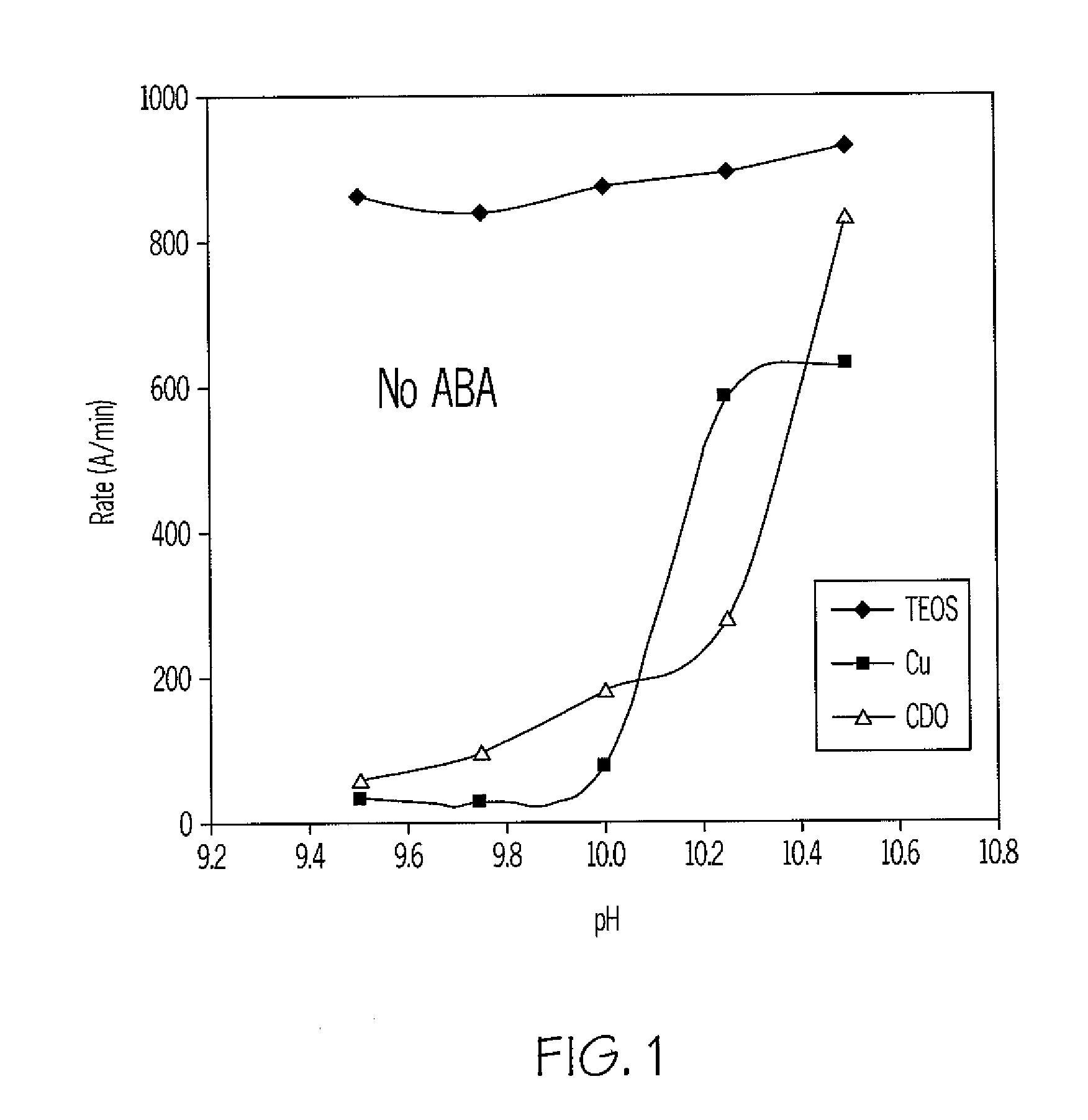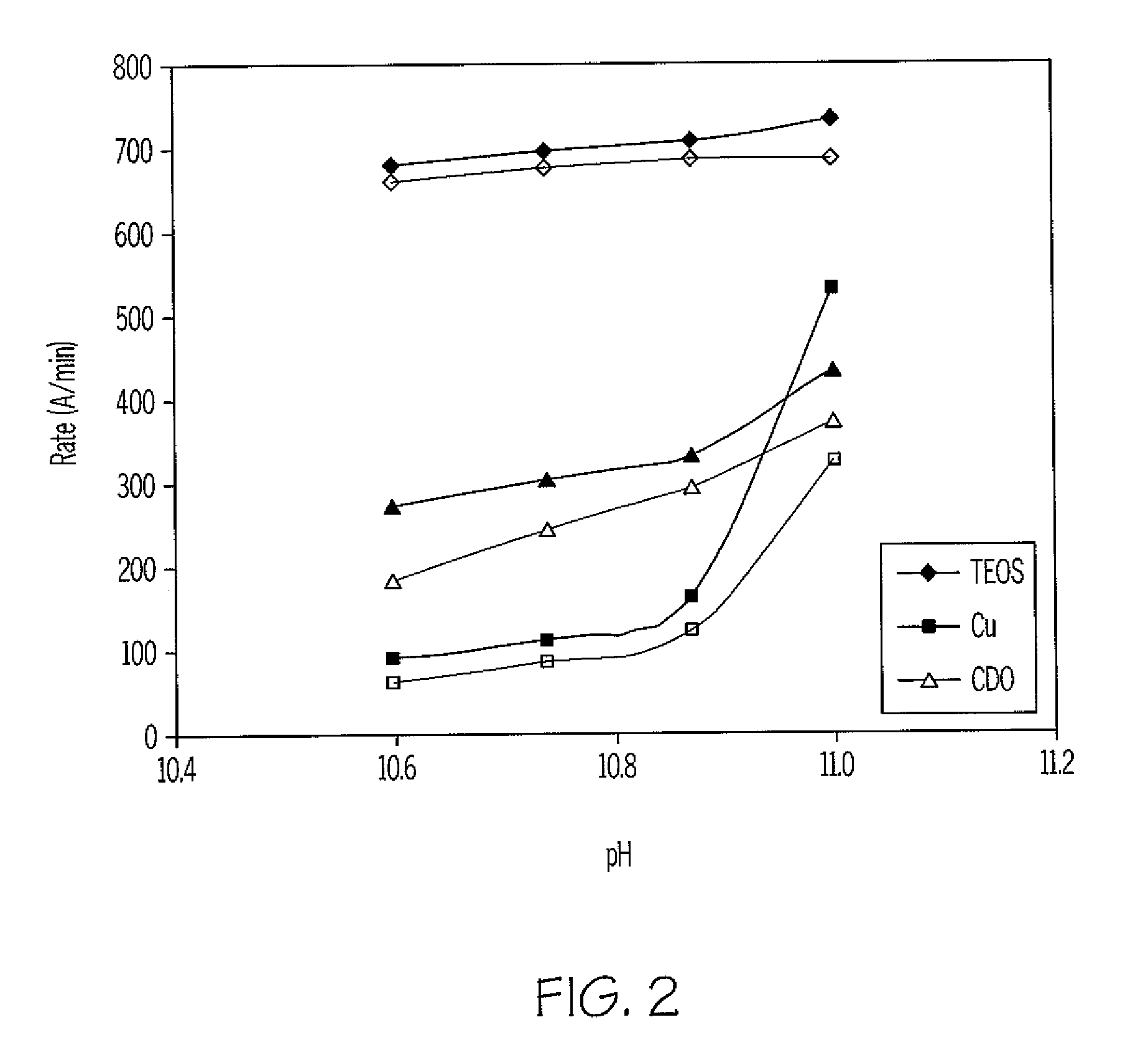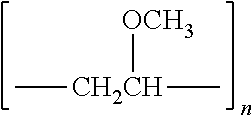Polymeric Barrier Removal Polishing Slurry
a technology of polymer barrier and polishing slurry, which is applied in the direction of electrical equipment, chemistry apparatus and processes, other chemical processes, etc., can solve the problems of new challenges for the integration of conventional chemical mechanical polishing (cmp) processes, and increasing the workload of polishing slurry for low k films
- Summary
- Abstract
- Description
- Claims
- Application Information
AI Technical Summary
Benefits of technology
Problems solved by technology
Method used
Image
Examples
example 1
[0034]An initial series of slurries varied BTA, poly(methyl vinyl ether), potassium phosphate and aminobutyric acid to determine polishing characteristics. Polishing data are below in Table 2.
TABLE 2CuNon-TEOSCDOCuUniformitySlurry(Å / min)(Å / min)(Å / min)(%)Ta164137129114.8High264335334412.1High36292783607.6High46663604115.6High568232637111.5High673153043311.5High76793884356.1High87034744903.5High966941028713.1High1067854134211.1High116573773508.3HighCDO equals Coral from Novellus; andHigh equals an expected tantalum removal rate of at least 400 Å / Min.
[0035]The above data show that varying BTA, poly(methyl vinyl ether), potassium phosphate and aminobutyric acid concentrations have no dramatic influence in TEOS, CDO and copper removal rates. Referring to FIGS. 1 and 2, FIG. 2 illustrates the removal rate stability achieved with the aminobutyric acid.
example 2
[0036]A second series of slurries varied BTA, poly(methyl vinyl ether), potassium phosphate and aminobutyric acid to determine polishing characteristics. Polishing data are below in Table 3.
TABLE 3CuNon-TEOSCDOCuUniformitySlurry(Å / min)(Å / min)(Å / min)(%)Ta126785574652.3High137166114583.7High147358735083.6High157326774982.3High167518075332.4High1780611245902.3High1882014735793.3HighCDO equals Coral from Novellus; andHigh equals an expected tantalum removal rate of at least 400 Å / Min.
[0037]The above data also show that varying BTA, poly(methyl vinyl ether), potassium phosphate and aminobutyric acid concentrations have no dramatic influence in TEOS, CDO and copper removal rates.
Table 2
example 3
[0038]A third series of slurries varied BTA, poly(methyl vinyl ether), potassium phosphate and aminobutyric acid to determine polishing characteristics for, copper and carbon-doped oxide, including carbon-doped oxide for patterned wafers. Polishing data are below in Table 4.
TABLE 4CuCDONon-PatternedCDOCuUniformityWaferSlurry(Å / min)(Å / min)(%)(Å / min)Ta1920727515320High2011631562354High2117830584366High2218727411378High2315826428305High2420828503407High2514824343266High2617725543354High2720727515320High2811631562354HighCDO equals Coral from Novellus;CDO Patterned Wafer equals Black Diamond from Applied Materials and High equals an expected tantalum removal rate of at least 400 Å / Min.
[0039]The above data show that varying BTA, poly(methyl vinyl ether), potassium phosphate and aminobutyric acid concentrations have no dramatic influence in CDO and copper removal rates. In addition, the above data show that varying BTA, poly(methyl vinyl ether), potassium phosphate and aminobutyric acid co...
PUM
| Property | Measurement | Unit |
|---|---|---|
| weight percent | aaaaa | aaaaa |
| weight percent | aaaaa | aaaaa |
| weight percent | aaaaa | aaaaa |
Abstract
Description
Claims
Application Information
 Login to View More
Login to View More - R&D
- Intellectual Property
- Life Sciences
- Materials
- Tech Scout
- Unparalleled Data Quality
- Higher Quality Content
- 60% Fewer Hallucinations
Browse by: Latest US Patents, China's latest patents, Technical Efficacy Thesaurus, Application Domain, Technology Topic, Popular Technical Reports.
© 2025 PatSnap. All rights reserved.Legal|Privacy policy|Modern Slavery Act Transparency Statement|Sitemap|About US| Contact US: help@patsnap.com



